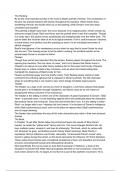The Painting
By far the most important symbol in the novel is Basil's portrait of Dorian. The centerpiece of
the plot, the portrait interacts with Dorian throughout the narrative. When Dorian does
something immoral, the results show up on the painting, while Dorian's own face stays
unmarked and beautiful.
This painting is Basil's best work, but must, because of its magical power, remain unseen by
everyone except Dorian. Basil and Henry saw the portrait when it was first complete. Though
it is rarely seen, this picture looms symbolically and metaphorically over the entire book. The
picture takes the Victorian ideal of art to its logical extreme. If art is useful because it teaches
a moral lesson, how perfect must this painting be since it is an immediate barometer of
ethical changes?
Basil's final glimpse of his masterpiece occurs when he says that to know Dorian he must
see his soul. This viewing proves to be the artist's undoing; his horrified reaction to the
portrait leads Dorian to murder his friend.
Flowers
Though they are far less important than the picture, flowers appear throughout the book. The
opening line mentions "the rich odour of roses," and it is to flowers that Dorian turns in
Chapter 2 to relieve his soul after Henry awakens him to the power and brevity of beauty.
Dorian buys or orders orchids at key moments, such as when he's blackmailing Alan
Campbell into disposing of Basil's body for him.
Flowers symbolize beauty and how briefly it lasts. Their fleeting beauty stands in stark
contrast to the enduring ugliness that is captured in Dorian's portrait. The title character
clings to something that is not meant to last, which brings inevitable repercussions.
Theater
The theater, as a type of art, serves as a form of escapism. Lord Henry advises that people
should give in to temptation through indulgence, and Dorian uses art as one means of
escaping the ethical concerns of his conscience.
The theater is the setting in which one of the characters of great importance to Dorian—Sibyl
Vane—is primarily seen. It is the backdrop against which she artistically plays the characters
that seduce Dorian into loving her. Once she and Dorian fall in love, it is the setting in which
Sibyl—no longer able to act—destroys his love forever. It is the place of Dorian's indulgence
while Sibyl's performances excel, and it is the place he rejects when Sibyl's performances
are no longer pleasing.
The theater also symbolizes the way all the main characters play roles in their own personal
dramas.
The Book
In Chapter 10 just after Dorian hides his portrait and learns the results of Sibyl Vane's
inquest, he reads the "yellow book" Henry sent him. This novel changes Dorian's life. He
buys multiple copies, rereads it, and lives its philosophy. This book, which he carries with
him wherever he goes, symbolizes several closely linked meanings. Most directly it
represents Henry's influence over Dorian. Generally, "controversial French novels" were
bound in yellow during this period, so this book represents the influence of French literature.
These yellow bound books were considered sensational at best, and decadent and immoral
at worst, promoting both sexual and philosophical deviance.
Most specifically, this can be read as Joris-Karl Huysmans's À Rebours, a book of the
decadent movement that Wilde read (and greatly admired) on his honeymoon. Once this
book enters Dorian's life, he begins to live like he is part of the aesthetic movement. He is




